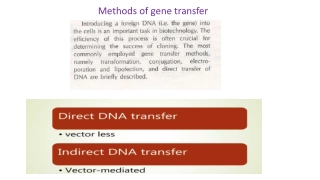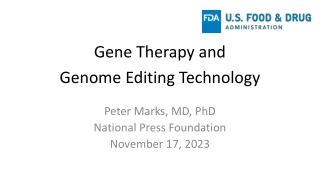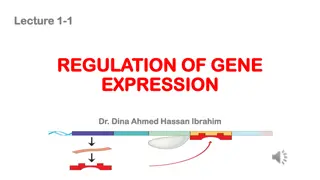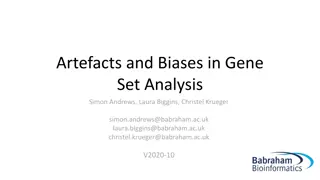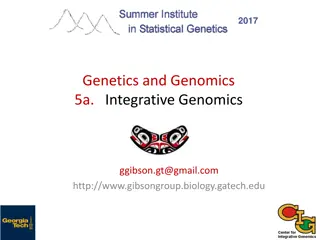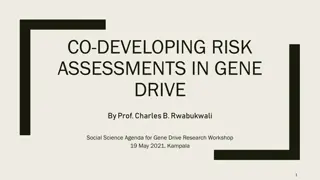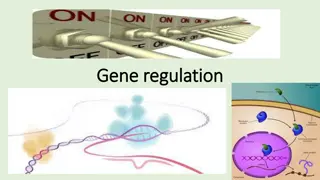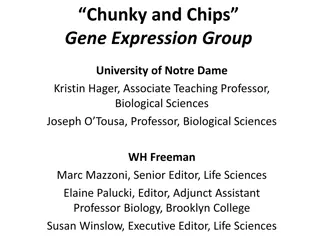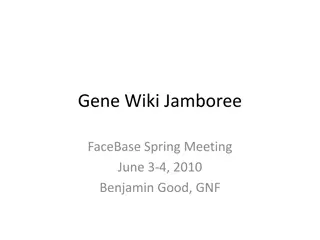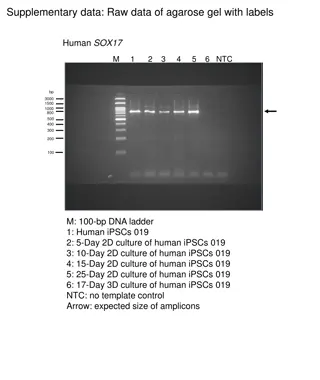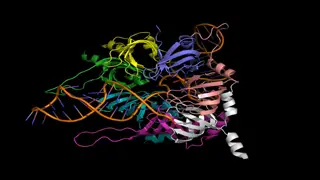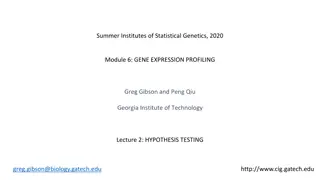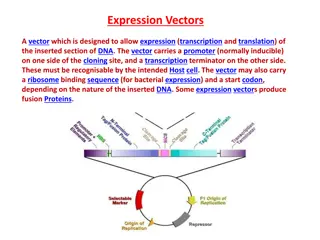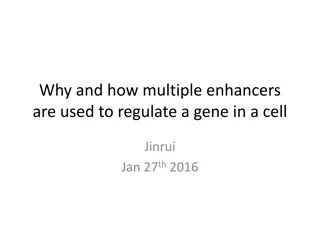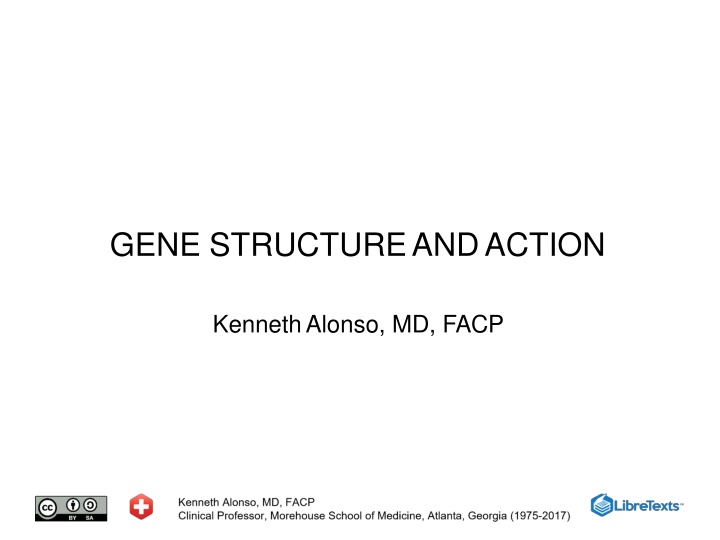
Gene Structure, Fertilization, and Chromosome Morphology in Genetics
Explore the intricate world of genetics with topics ranging from gene structure and action to chromosome morphology and pedigree nomenclature. Dive into the mechanisms of fertilization, human karyotypes, and chromosome banding techniques. Discover the significance of fluorescence in situ hybridization (FISH) and other advanced methods in genetic analysis.
Download Presentation

Please find below an Image/Link to download the presentation.
The content on the website is provided AS IS for your information and personal use only. It may not be sold, licensed, or shared on other websites without obtaining consent from the author. If you encounter any issues during the download, it is possible that the publisher has removed the file from their server.
You are allowed to download the files provided on this website for personal or commercial use, subject to the condition that they are used lawfully. All files are the property of their respective owners.
The content on the website is provided AS IS for your information and personal use only. It may not be sold, licensed, or shared on other websites without obtaining consent from the author.
E N D
Presentation Transcript
GENE STRUCTUREANDACTION KennethAlonso, MD, FACP
Fertilization Fig. 25-2 Accessed 07/01/20102000.)
Human male karyotype Giemsa banded human chromosomes arranged by size and banding (Reproduced with permission, from Lingappa VJ, Farey K: Physiological Medicine. McGraw-Hill, 2000.) Fig. 25-2 Accessed07/01/2010
Chromosome morphology Named for relative length of arms (p, short arm; q, long arm). Defined by position of centromere joining sister chromatids of metaphase chromosomes. Some short arms are only stalk and satellite.
Pedigree nomenclature 46, XY Normal male 47,XX,+21/46 XX Female mosiac for trisomy 21 46, XY del 4 (p14) Male with distal deletion of the short arm of chromosome 4 band designated 14 46, XX, dup (5p) Female with duplication of the short arm of chromsome 5 46, XX, t(11:22)(q23:q22) Female with a balanced reciprocal translocation between the long arms of chromosomes 11 and 22 46, XY, inv 3 (p21;q13) Male with a pericentric inversion on chromosome 3
Chromosome banding Techniques to stain chromosomes differentially by composition after cells cultured and stimulated by mitogen to divide. G-banding uses Giemsa and trypsin. R-banding is reverse of G-band pattern. C-banding stains centromeres. Q-banding uses quinacrine fluorescence and stains as do G-bands. High resolution banding permits identifications of more bands as it is performed at an earlier state of condensation of chromosome material.
FISH Fluorescence in situ hybridization (FISH) Hybridize DNAprobe labeled with dye. Fluorescent spot corresponds to probe location. Can locate specific genes. Can be applied to interphase nuclei (no need to stimulate cell to divide). Shows changes in number of chromosomes
Other banding methods Spectral karyotyping Use probes specific to each chromosome. Each has different fluorescent label. All chromosomes labeled different colors. Easy to see rearrangements Competitive genomic hybridization Make probes from total DNA of subject and control with different labels. Hybridize both to normal chromosomes. Excess of label shows excess or deficiency of DNAfrom that sample as compared to control. Allele specific serotyping Probe hybridizes to DNAof interest.
Nucleic acids The genetic code uses 4 letter nuclide alphabet: the purines adenine and guanine; the pyrimidines cytosine and thymidine. Glycine, aspartate, and glutamine are amino acids necessary for purine synthesis.
Purine synthesis 10 steps Begins with ribose-5-phosphate (from the HMP pathway). It reacts withATP (and pyridoxine) to form pyridoxal ribose-5-phosphate pyrophosphate (PRPP). An amine group is added, releasing the pyrophosphate. These two are the rate-controlling reactions for the pathway. Glutamine pyridoxal pyrophosphate amidotransferase is the rate limiting step. The final product is Inosine monophosphate, which can be converted toAMP and GMP.
Pyrimidine synthesis 6 steps Begins with the production of carbamoyl phosphate from glutamine, ATP, and bicarbonate. Aspartate is added and the ring is closed, producing orotic acid. PRPP is added and the compound decarboxylated, producing uracil monophosphate (UMP) which can be converted to cytidine triphosphate (CTP). UMP must be converted to dUMP and a carbon atom transferred (tetrahydrofolate reductase critical) to end with deoxy thymidine monophosphate (dTNP).
Pyrimidine synthesis Aspartate transcarbamylase is the rate limiting step. Aspartate alone is necessary for pyrimidine synthesis. Uracil arises from the deamination of cytosine.
Nucleic acid structure Nucleotides (nucleic acid plus ribose plus phosphate) are linked by 3 -5 phosphodiester bond. Deoxyribonucleotides are produced by reduction of ribonucleotides (lose Oxygen at the 2 position).ATP stimulates the reaction. NADH is the final reducing agent. Double-stranded DNAforms a helical structure. Bases are stacked; ring structures make them essentially flat. Offset nature of backbone creates major and minor grooves. (Bases more exposed in major groove.)
-helix Hydrogen bonds (dotted lines) formed between H and O atoms stabilize a polypeptide in an -helical conformation. The side chains (R) are on the outside of the helix. The van der Waals radii of the atoms are larger than shown here; hence, there is almost no free space inside the helix. (Reprinted, with permission, from Haggis GH et al: Introduction to Molecular Biology. Wiley, 1964, with permission of Pearson Education Limited.) Fig 5-4 Accessed08/01/2010
Nucleic acid structure DNAis largely in B form (two antiparallel strands in a right handed helix with the bases on the inside and the phosphodiester backbone on the outside). Proteins can interact directly with the bases in the DNAmajor groove. 10 bases per helical turn. Guanidine-cytosine base pairs contain 3 Hydrogen bonds; adenine-thymine have 2 Hydrogen bonds, less tightly bound. Melting temperature (denaturation) linearly related to guanidine and cytosine content.
Nucleic acid structure Metabolically inactive DNAin Z form Left handed helix with bases on inside Azig-zag structure 12 bases per helical turn Repeating guanidine-cytosine nucleotides in which the 5-position of cytosine is methylated. RNAdoes not form an extended helix as does DNA. Stem and loop forms (Aforms). Mitochondrial DNAis circular.
Genome The organization of genomes is characterized by a high degree or order and non-randomness. There is physical segregation of transcriptionally active euchromatin from repressed heterochromatin into distinct regions in the cell nucleus Chromatin domains and genes are distributed to preferred locations within the nuclear space Many proteins are non-randomly distributed in the nucleus, and are found in sub-nuclear bodies such as the nucleolus, the Cajal body, and splicing factor speckles
Genome The two alleles of a gene often differ in their three- dimensional 3D position and their functional status in the same nucleus Many chromatin-chromatin interactions only occur with low frequency in individual cells in a population The shape and number of nuclear bodies fluctuates considerably among individual cells
Chromosome structure The chromatin fiber is made up of units of 146 base pairs (bp) of DNAwrapped around nucleosomes that consist of octamers of core histone proteins Histone 1 ties nucleosome beads together in a string. The nucleosome core consists of histones H2A, H2B, H3, and H4. The chromatin fiber self-interacts to form loops At the smallest scale, loops mediate the interaction of regulatory elements, often enhancers with gene promoters, over distances of 10 to several hundred kb
Chromosome structure Multiple enhancers may loop to form super enhancer clusters thought to integrate signaling events or to act redundantly on target genes Larger loops (up to Mbs in length) contribute to the 3D compaction of the genome Used to regulate gene clusters in a precise temporal and spatial fashion via the sequential association of upstream elements with individual target genes Aggregates of phase-separated transcription factors bring genome regions into spatial proximity without the need for direct chromatin-chromatin interaction
Chromosome structure Chromatin domains that preferentially interact with each other rather than with their surrounding sequencesare referred to as topologically associating domains (TADs) They are typically several hundred kb in size and form by a loop-extrusion mechanism The cohesin complex drives the formation of chromatin loops via itsATP dependent molecular motor activity The extruded loop then folds onto itself to form a domain whose boundaries are defined by the architectural chromatin protein CTCF
Chromosome structure Architectural boundaries restrict interactions of regulatory elements Euchromatin and heterochromatin elements segregated Throughout interphase, the DNA that makes up a single chromosome occupies a relatively compact, spatially restricted territory of the nucleus rather than being dispersed through the nuclear space The chromosome has a high surface-to-volume ratio because its interior is permeated by a complex network of anastomosed channels that facilitate the access of regulatory factors to chromatin.
Chromosome structure The chromatin fibers of neighboring chromosomes often intermingle, but do not entangle, at their periphery, thus creating a continuum of chromatin throughout the nuclear space Inactive genes often locate near the nuclear edge and associate with peripheral heterochromatin, whereas active genes are frequently located in the nuclear interior The chromatin fiber is a self-avoiding polymer that can undergo local diffusive motion and is constrained by its polymer structure TADs are self-emergent properties of the polymer Promoted by cohesion and CTCF
Genome dynamics A transcription factor typically spends >95% of its time in a diffusive state or is engaged in non-specific interactions, with dwell-times on the order of several 100 ms Only a small fraction of a given transcription factor at any time is bound at specific sites The short dwell time of transcription factors ensures that functional complexes on chromatin are not locked into a permanent state Despite the transient nature of the individual binding events, the resulting chromatin states are stable due to the continuous replacement of dissociating proteins.
Genome dynamics Functional plasticity Phase separation is a driver of chromosome organization The demixing of distinct protein populations when present above a saturation threshold due to their propensity to preferentially undergo homotypic rather than heterotypic interactions with other biomolecules, leading to the formation of segregated, dynamic phases ( Phase separation mediates the biogenesis of membrane-less nuclear and cytoplasmic compartments
Genome dynamics The nuclear envelope acts as a major constraint in the 3D organization of genomes because specific genome regions are tethered to the periphery LamininAprominent role Nuclear bodies also act as constraints Most genes do not continuously engage the transcription machinery Oscillate between dynamic on and off states and undergo transcriptional bursting Stochastic
Misteli, The Self-Organizing Genome: Principles of GenomeArchitecture and Function, Cell (2020), https:// doi.org/10.1016/j.cell.2020.09.014
Misteli, The Self-Organizing Genome: Principles of GenomeArchitecture and Function, Cell (2020), https:// doi.org/10.1016/j.cell.2020.09.014
Misteli, The Self-Organizing Genome: Principles of GenomeArchitecture and Function, Cell (2020), https:// doi.org/10.1016/j.cell.2020.09.014
Genome dynamics The dynamic and stochastic nature of the genome, combined with the presence of genetic feedback loops and a strong attractor in the form of cell-type- defining gene expression programs, confers to genomes all major hallmarks of self-organization.
DNA replication Replication begins at consensus sequence of adenine-thymidine rich base pairs. Semi-conservative. Single origin of replication Continuous bidirectional DNAsynthesis on leading strand Discontinuous on lagging strand. Replication fork is where leading and lagging strands are synthesized.
DNA replication Helicase unwinds the DNA template at the replication fork by breaking Hydrogen bonds. Single stranded binding protein prevents reannealing of strands. Topoisomerase creates a nick in the helix to relieve tension of supercoils.
Role of topoisomerase Double stranded molecule must separate Each strand is template for new complement Antiparallel nature of strands means new strands are produced in slightly different ways Mitochondrial DNAis condensed by wrapping the circular DNAaround itself, forming a supercoil. Superhelical turns, in the opposite direction, are produced so that the number of turns per base pairs remains unchanged.
Role of topoisomerase Toposiomerase I (swivelase) Uses noATP Cuts one strand and allows to rejoin ends. Operates on positive supercoil. Positive supercoiling occurs during strand separation during DNAreplication.
Role of topoisomerase Toposiomerase II (gyrase) UsesATP Produce and remove supercoils (can cut both strands). Negative supercoil as wound or unwound Energy for unwinding comes in part from reducing strain of negative supercoil.
Transcription to Translation Fig. 1-15 Accessed 07/01/2010
DNA replication DNAprimase makes an RNAprimer on the lagging strand on which DNA polymerase III can initiate replication. Strands have a direction set by the backbone. Strands are synthesized from a 5 to 3 direction. 5 -3 direction of synthesis as the 5 end bears the triphosphate energy source for the bond. Exonuclease activity proofreads in a 3 -5 direction Paired strands run in opposite directions (anti- parallel). Necessary for hydrogen bonding to hold strands together.
DNA replication One strand properly oriented for continuous synthesis (leading). Replication fork opens up ahead of DNApolymerase . Elongates leading strand at the 3 end polymerase in proper direction.
DNA replication The lagging strand is synthesized in opposite direction, away from fork. Replication fork uncovers DNAbehind DNA polymerase I Has to start many times. Stops elongation of the lagging chain when it reaches the primer of the preceding fragment. Degrades RNAprimer Lagging strand replicated in short segments, Okazaki fragments, each beginning with a 5 RNA primer.
DNA replication DNApolymerase I excises RNAprimer from the lagging strand with 5 -3 exonuclease. DNApolymerase I is also a repair enzyme. DNAligase seals the DNAof the lagging strand. DNA from previous Okazaki fragment serves as primer to fill gaps left by removal of RNA primer (circular chromosome). DNApolymerase I replicates mitochondrial DNA.
DNA replicaiton With nuclear DNA, telomerase enzyme adds a six base sequence,AGGGTT, to the 3 end of the DNA template by reverse transcription. RNAprimer is again formed and a daughter strand synthesized. DNAligase attaches the newly synthesized DNAto the daughter strand. Primer and added DNAare cleaved. Thus, the chromosome does not increase in size with each replication.
DNA damage Heat damages purines preferentially. Adenine is also deaminated to hypoxanthine and cytosine to uracil with heat exposure. Adenine phosphate endonuclease removes the base. UV light dimerizes pyrimidine residues which are adjacent in the same strand of DNA (usually thymidine). Benz(a)pyrene from cigarette smoke oxidized in body affects guanine.
DNA repair DNAis repaired by excising the damaged base on the 5 side of the damage, leaving a 3 hydroxyl group to act as primer for re-synthesis. Alterations of a single strand of DNAare the most common aberration. Generally endogenous.
DNA repair mechanisms DNAsingle strand breaks are repaired by using the intact complementary strand as a template by: BER (base excision repair) NER (nuclear excision repair) MMR (mismatch repair).
DNA repair mechanisms BER is the principal repair mechanism. PARP1 binds the broken single strand. PARP1 catalyzes the formation of large branched chains of poly-ADP-ribose from its NAD+substrate. This results in the poly-ADP ribosylation of PARP itself, XRCC1, and -polymerase. This enables the single stranded break to be repaired.
BER Removes a single damaged base DNAglycolase removes hypoxanthine and uracil from DNAas single base in the G1 phase.
NER Replaces a group of damaged base pairs An excision endonuclease recognizes thymidine dimers in the G1 phase. This enzyme is deficient in Xeroderma pigmentosum. No repair upon exposure to UVB light O-methyl guanosine demethylase removes guanosine methylated at the sixth Oxygen position as a single base in the G1 phase If unrepaired it will pair with thymidine during replication.
NER Cockayne s syndrome Autosomal recessive ERCC6 gene at 10q11.23; ERCC8 gene at 5q12.1 NER Also unable to repair UV damage. Photosensitive In contrast to xeroderma pigmentosum, no melanoma develops.
NER Trichothiodystrophy Heterogeneous group Autosomal recessive ERCC2 gene at 19q13.32; ERCC3 at 2q14.3; GTFHID gene at 6q25.3 are part of general IH transcription complex NER defect. Sulfur rich brittle hair and nails Associated with photosensitivity. MPLKIP gene at 7p14.1 not associated with photosensitivity

